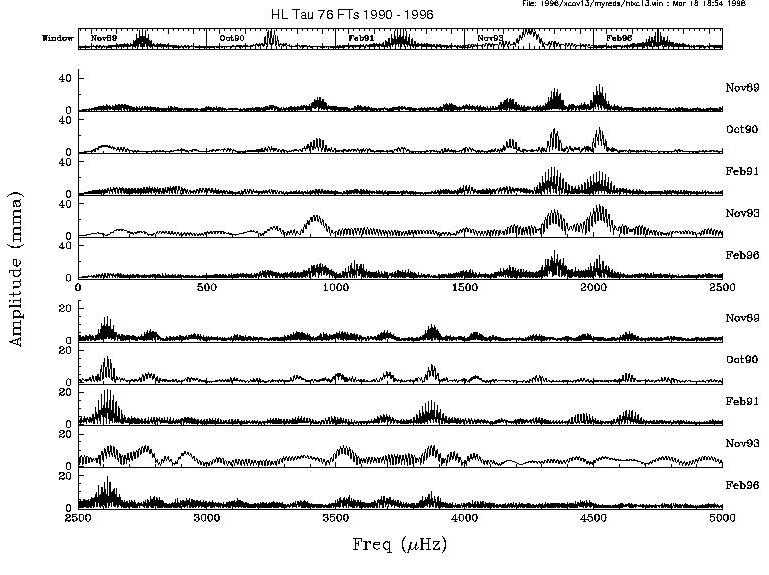Click on each plot to download a gzipped postscript version.

HL Tau 76 FT over several seasons.
HL Tau 76 is a large-amplitude cool DAV. It was the first DAV (ZZ~Ceti) star discovered and has been extensively observed with single-site observations that have failed to resolve several regions of power. A sample FT is shown below. We hope to use full primary WET coverage to resolve the star's many-mode pulsations and finish with a complete enough set of modes for full asteroseismological measurements of a single DAV.
For more information,
consult the full HL Tau 76 Scientific
Justification.
A sample lightcurve
is shown in a figure at the bottom of this page.
| R.A. (J2000) = 04 18 59 |
| Dec. (J2000) = +27 18 20 |
| mv = 15.2 |
Control Center: The Xcov 18 control center is at Iowa State University's International Institute of Theoretical and Applied Physics (IITAP).
Contacting the Control Center: Consult the Phone Contact List for information on phone, fax, and email for the control center. See the Xcov18 People List for contact information for the other Xcov18 active sites.
Time Check: Please do a clock time check each night before taking data and verify your time with HQ at the beginning of the run, and as often during the run as possible. HQ will have an accurate clock available for phone clock checks. We had many problems with time during Xcov17, so please, check the time before each run!
Data Transfer: There are two ways to send your data and logs at the end of each night.
Observing Logs: We ask that you send a copy of your observation log along with the data, at the same time if you can.
Run start: Please start your run on an integral multiple of ten seconds (times ending in "0"). Check the computer clock just before the start of a run, synchronizing with your master clock to within 0.1 sec if possible.
Integration time: Use 10 seconds integration time for PMT-based systems. Those with CCDs will have to use their judgement (and/or confer with HQ) to obtain the appropriate balance between signal to noise, cycle time, and duty time.
Filters: Use NO filter in all channels. If you are using a blue-sensitive CCD, also please use no filter unless you have a CuSO4 filter available, in which case please contact us at HQ.
Guide star: Please consult the finder charts and use the marked star if possible; either way, please record your ch2 offsets and telescope plate scale so we can verify exactly which star was observed.
Sky calibration: Observers with 3-channel photometers should record sky in all three channels near the beginning and possibly the end of each run to permit accurate cross calibration. Observers with 2 channel photometers should take sky by moving the telescope. We have sometimes in the past used the channel 2 verniers to measure channel 2 sky (only) but we find this is not really reliable. Try to take sky as often as needed, at least once per 1/2 hour, for 3 - 5 good sky points; more are not needed and cause unwanted data gaps in the light curve of the target star.
Apertures: Please use the smallest aperture consistent with getting data of good quality (e.g. no visible loss of light to the edge of the aperture). A general rule of thumb is to use an aperture approximately 8-10 times the diameter of the seeing disk. (An aperture too small can lead to light loss out the edges; one too large adds additional sky noise and possibly opens the field up to nearby contaminating stars.) Record the size of the aperture (in arcsec) in your observing log.
Click on each plot to download a gzipped postscript version.

HL Tau 76 FT over several seasons.